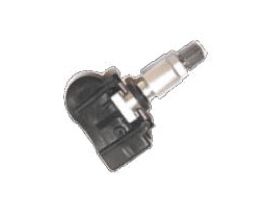Kia Optima Hybrid: Tire Pressure Monitoring System / TPMS Sensor Description and Operation
| Description |

| 1. |
Function
|
| 2. |
Structure and features
|
| 3. |
Mode
|
| • |
Wheel angular velocity of wheels are different from each other in the following cases: |
| 1) |
Slip for each axis occurs differently. |
| 2) |
Rotation radius (the radius of curve) for each wheel is different. |
| 3) |
Tire wear, internal pressure, tire specifications, etc. for each tire are different. |
| • |
TPMS sensor is transmitted to RF signal at only specific phase (the angle of the tire) in the learning mode. |
| • |
TPMS receiver checks each tire phase (tire angle) information on receiving RF signals from the sensor. |
| • |
Every time RF signals from sensor IDs 1, 2, 3, and 4 are
received, the ID with the highest correlation among the phase of each
collected wheel is transmitted. (In other words, each time RF signal is
received, the phase of the tire is transmitted to the most constant
wheel.) |
| • |
TPMS sensor transmits the RF signal at intervals of 16 seconds in the learning mode. |
| • |
After stopping or parking for more than 19 minutes, automatic learning function in every driving position is performed. |
| • |
The sensor is converted to Parking Mode when stopped or
parked for more than 15 minutes. When acceleration of over 4g
(15-20km/h) is detected in Parking Mode, it is converted to First Block
Mode. |
| 1. |
Normal Mode
Function
[Normal operation]
[Abnormal operation]
|
| 2. |
Virgin mode
Function
[Normal operation]
|
| 3. |
Low pressure lamp
Function
[Normal operation]
[Low pressure lamp on operation]
|
| 4. |
Malfunction lamp
Function
[Normal operation]
[Malfunction lamp on operation]
|
| 1. |
Receiver exchange position
: Diagnostic Equipment (TPMS exciter included) will conduct the following tasks.
|
 Description and Operation
Description and Operation
Description Tread Lamp – Tire Under Inflation / Leak Warning. 1. Turn on condition • When tire pressure is below allowed threshold • When rapid leak is detected by the sensor. 2. Turn off condition ...
 TPMS Sensor Repair procedures
TPMS Sensor Repair procedures
Removal Tire Removal 1. Deflate tire & remove balance weights. • The tire bead should be broken approx. 90° from the valve side of the wheel. The bead breaker should not be set too ...
Other information:
Kia Optima Hybrid (TF HEV) 2016-2020 Service Manual: Front Washer Motor Repair procedures
Inspection 1. With the washer motor connected to the reservoir tank, fill the reservoir tank with water. Before filling the reservoir tank with water, check the filter for foreign material or contamination. if necessary, clean the filter. 2. Connect positive (+) battery cables to terminal ...
Kia Optima Hybrid (TF HEV) 2016-2020 Service Manual: Catalytic Converter Description and Operation
Description The catalytic converter of the gasoline engine is a three way catalyst. It oxidizes carbon monoxide and hydrocarbons (HC), and separates oxygen from the oxides of nitrogen (NOx). ...



